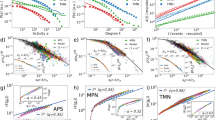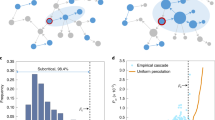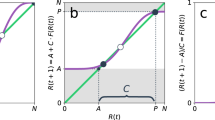Abstract
Mathematical models of social contagion that incorporate networks of human interactions have become increasingly popular, however, very few approaches have tackled the challenges of including complex and realistic properties of socio-technical systems. Here, we define a framework to characterize the dynamics of the Maki–Thompson rumour spreading model in structured populations, and analytically find a previously uncharacterized dynamical phase transition that separates the local and global contagion regimes. We validate our threshold prediction through extensive Monte Carlo simulations. Furthermore, we apply this framework in two real-world systems, the European commuting and transportation network and the Digital Bibliography and Library Project collaboration network. Our findings highlight the importance of the underlying population structure in understanding social contagion phenomena and have the potential to define new intervention strategies aimed at hindering or facilitating the diffusion of information in socio-technical systems.
This is a preview of subscription content, access via your institution
Access options
Access Nature and 54 other Nature Portfolio journals
Get Nature+, our best-value online-access subscription
$29.99 / 30 days
cancel any time
Subscribe to this journal
Receive 12 print issues and online access
$209.00 per year
only $17.42 per issue
Buy this article
- Purchase on Springer Link
- Instant access to full article PDF
Prices may be subject to local taxes which are calculated during checkout



Similar content being viewed by others
Code availability
Code is available upon request from the corresponding author.
References
Hufnagel, L., Brockmann, D. & Geisel, T. Forecast and control of epidemics in a globalized world. Proc. Natl Acad. Sci. USA 101, 15124–15129 (2004).
Colizza, V., Barrat, A., Barthelemy, M. & Vespignani, A. The role of the airline transportation network in the prediction and predictability of global epidemics. Proc. Natl Acad. Sci. USA 103, 2015–2020 (2006).
Halloran, M. E. et al. Modeling targeted layered containment of an influenza pandemic in the United States. Proc. Natl Acad. Sci. USA 105, 4639–4644 (2008).
Marathe, M. & Vullikanti, A. K. S. Computational epidemiology. Commun. ACM 56, 88–96 (2013).
Heesterbeek, H. et al. Modeling infectious disease dynamics in the complex landscape of global health. Science 347, aaa4339 (2015).
Liu, Q.-H. et al. Measurability of the epidemic reproduction number in data-driven contact networks. Proc. Natl Acad. Sci. USA 115, 12680–12685 (2018).
Goffman, W. Mathematical approach to the spread of scientific ideas—the history of mast cell research. Nature 212, 449–452 (1966).
Moreno, Y., Nekovee, M. & Pacheco, A. F. Dynamics of rumor spreading in complex networks. Phys. Rev. E 69, 066130 (2004).
Bettencourt, L. M., Cintrón-Arias, A., Kaiser, D. I. & Castillo-Chávez, C. The power of a good idea: quantitative modeling of the spread of ideas from epidemiological models. Physica A 364, 513–536 (2006).
GLEAMviz: The Global Epidemic and Mobility Model; http://www.gleamviz.org/
Centola, D. How Behavior Spreads: The Science of Complex Contagions Vol. 3 (Princeton Univ. Press, 2018).
Guilbeault, D., Becker, J. & Centola, D. in Complex Spreading Phenomena in Social Systems (eds Lehmann, S. & Ahn, Y.-Y) 3–25 (Springer, 2018).
Lehmann, S. & Ahn, Y.-Y. (eds) Complex Spreading Phenomena in Social Systems (Springer, 2018).
Axelrod, R. The dissemination of culture: a model with local convergence and global polarization. J. Conflict Resolution 41, 203–226 (1997).
Baronchelli, A., Felici, M., Loreto, V., Caglioti, E. & Steels, L. Sharp transition towards shared vocabularies in multi-agent systems. J. Stat. Mech. 2006, P06014 (2006).
Centola, D., Becker, J., Brackbill, D. & Baronchelli, A. Experimental evidence for tipping points in social convention. Science 360, 1116–1119 (2018).
Moreno, Y., Nekovee, M. & Vespignani, A. Efficiency and reliability of epidemic data dissemination in complex networks. Phys. Rev. E 69, 055101(R) (2004).
Gleeson, J. P., O’Sullivan, K. P., Baños, R. A. & Moreno, Y. Effects of network structure, competition and memory time on social spreading phenomena. Phys. Rev. X 6, 021019 (2016).
Volkening, A. Linder, D. F. Porter, M. A. & Rempala, G. A. Forecasting elections using compartmental models of infection. Preprint at https://arxiv.org/abs/1811.01831 (2019).
Centola, D. & Macy, M. Complex contagions and the weakness of long ties. Am. J. Sociol. 113, 702–734 (2007).
Granovetter, M. Threshold models of collective behavior. J. Am. Sociol. 83, 1420–1443 (1978).
Watts, D. J. & Dodds, P. in The Oxford Handbook of Analytical Sociology (eds Bearman, P. & Hedström, P.) 475–497 (Oxford University Press, 2017).
Baronchelli, A. The emergence of consensus: a primer. R. Soc. Open Sci. 5, 172189 (2018).
Daley, D. J. & Kendall, D. G. Epidemics and rumours. Nature 204, 1118 (1964).
Maki, D. P. & Thompson, M. Mathematical Models and Applications: With Emphasis on the Social Life, and Management Sciences (Prentice-Hall, 1973).
Zanette, D. H. Dynamics of rumor propagation on small-world networks. Phys. Rev. E 65, 041908 (2002).
Kempe, D., Kleinberg, J. & Tardos, É. Maximizing the spread of influence through a social network. In Proc. Ninth ACM SIGKDD Int. Conf. Knowledge Discovery and Data Mining KDD03 137 (ACM Press, 2003).
Kosfeld, M. Rumours and markets. J. Math. Econ. 41, 646–664 (2005).
Liu, Z. & Bambi, H. U. Epidemic spreading in community networks. Europhys. Lett. 72, 315–321 (2005).
Nekovee, M., Moreno, Y., Bianconi, G. & Marsili, M. Theory of rumour spreading in complex social networks. Physica A 374, 457–470 (2007).
Borge-Holthoefer, J., Meloni, S., Gonçalves, B. & Moreno, Y. Emergence of influential spreaders in modified rumor models. J. Stat. Phys. 151, 383–393 (2013).
Nematzadeh, A., Rodriguez, N., Flammini, A. & Ahn, Y.-Y. in Complex Spreading Phenomena in Social Systems (eds Lehmann, S. & Ahn, Y.-Y.) 97–107 (Springer, 2018).
Vespignani, A. Modeling dynamical processes in complex socio-technical systems. Nat. Phys. 8, 32–30 (2012).
Karsai, M., Perra, N. & Vespignani, A. Time varying networks and the weakness of strong ties. Sci. Rep. 4, 4001 (2014).
Fumanelli, L., Ajelli, M., Manfredi, P., Vespignani, A. & Merler, S. Inferring the structure of social contacts from demographic data in the analysis of infectious diseases spread. PLoS Comput. Biol. 8, e1002673 (2012).
Daley, D. J. & Gani, J. Epidemic Modelling: An Introduction (Cambridge Univ. Press, 1999).
Barrat, A., Barthelemy, M. & Vespignani, A. Dynamical Processes on Complex Networks (Cambridge Univ. Press, 2008).
Levins, R. Some demographic and genetic consequences of environmental heterogeneity for biological control. Bull. Entomol. Soc. Am. 15, 237–240 (1969).
Keeling, M. J. Metapopulation moments: coupling, stochasticity and persistence. J. Anim. Ecol. 69, 725–736 (2000).
Murrell, D. J. & Law, R. Beetles in fragmented woodlands: a formal framework for dynamics of movement in ecological landscapes. J. Anim. Ecol. 69, 471–483 (2000).
Colizza, V. & Vespignani, A. Epidemic modeling in metapopulation systems with heterogeneous coupling pattern: theory and simulations. J. Theor. Biol. 251, 450–467 (2008).
Perra, N., Gonçalves, B., Pastor-Satorras, R. & Vespignani, A. Activity driven modeling of time varying networks. Sci. Rep. 2, 469 (2012).
Nadini, M. et al. Epidemic spreading in modular time-varying networks. Sci. Rep. 8, 2352 (2018).
Balcan, D. & Vespignani, A. Phase transitions in contagion processes mediated by recurrent mobility patterns. Nat. Phys. 7, 581–586 (2011).
Balcan, D. et al. Seasonal transmission potential and activity peaks of the new influenza A(H1N1): a Monte Carlo likelihood analysis based on human mobility. BMC Med. 7, 45 (2009).
Balcan, D. et al. Modeling the spatial spread of infectious diseases: the global epidemic and mobility computational model. J. Comput. Sci. 1, 132–145 (2010).
Yang, J. & Leskovec, J. Defining and evaluating network communities based on ground-truth. Knowl. Inf. Syst. 42, 181–213 (2015).
Leskovec, J. & Krevl, A. SNAP Datasets: Stanford Large Network Dataset Collection; http://snap.stanford.edu/data
Acknowledgements
N.P. was supported in part by the US Army Research Laboratory and the US Army Research Office under contract/grant number W911NF-18-1-0376. Y.M. acknowledges partial support from the Government of Aragón, Spain through grant E36-17R, by MINECO and FEDER funds (grant FIS2017-87519-P) and from Intesa Sanpaolo Innovation Center. The funder had no role in study design, data collection, and analysis, decision to publish, or preparation of the manuscript.
Author information
Authors and Affiliations
Contributions
J.T.D., N.P., Y.M. and A.V. designed the research. J.T.D., A.V. and Q.Z. performed research and analysed data. All authors wrote the manuscript.
Corresponding author
Ethics declarations
Competing interests
The authors declare no competing interests.
Additional information
Peer review information Nature Physics thanks Damon Centola, Chris Danforth and Hawoong Jeong for their contribution to the peer review of this work.
Publisher’s note Springer Nature remains neutral with regard to jurisdictional claims in published maps and institutional affiliations.
Supplementary information
Source data
Source Data Fig. 2
Data to remake Fig. 2 plots.
Source Data Fig. 3
Data to remake Fig. 3a,b.
Rights and permissions
About this article
Cite this article
Davis, J.T., Perra, N., Zhang, Q. et al. Phase transitions in information spreading on structured populations. Nat. Phys. 16, 590–596 (2020). https://doi.org/10.1038/s41567-020-0810-3
Received:
Accepted:
Published:
Issue Date:
DOI: https://doi.org/10.1038/s41567-020-0810-3
This article is cited by
-
A novel epidemic network model incorporating infections induced by exposed individuals and environments
Nonlinear Dynamics (2024)
-
Complexity of Government response to COVID-19 pandemic: a perspective of coupled dynamics on information heterogeneity and epidemic outbreak
Nonlinear Dynamics (2023)
-
From subcritical behavior to a correlation-induced transition in rumor models
Nature Communications (2022)
-
Group interactions modulate critical mass dynamics in social convention
Communications Physics (2022)
-
Unfolding the multiscale structure of networks with dynamical Ollivier-Ricci curvature
Nature Communications (2021)



